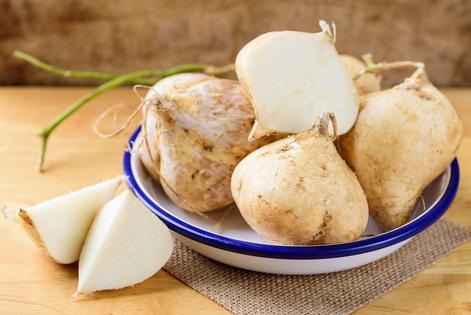Environmental Nutrition: Here’s to jicama
Published in Health & Fitness
Rough-skinned and oddly shaped, jicama is rather humble looking. A peek inside reveals a creamy white flesh with the crisp and juicy texture of a pear and the mild sweetness of a water chestnut.
The folklore
Also known as yam bean or Chinese potato, jicama remains a popular ingredient in global cuisine, known for its uniqueness and versatility, and as a good source of fiber and vitamin C.
The facts
Part of the bean family of plants, jicama (Pachyrhizus erosus) is related to chickpeas, green beans, and peas. Jicama refers to the slow growing root, but above ground, it grows similar to other pole beans, vining and flowering. About 90 percent water, jicama is refreshing, hydrating, and low in calories. A one-cup serving has just 49 calories, but is an excellent source of fiber to satisfy hunger. It’s an excellent source of vitamin C, with nearly 30 percent of the recommended daily value, as well as smaller amounts of iron, potassium, folate, and magnesium.
The findings
Jicama is high in fiber, including inulin, a type of soluble dietary fiber that may support digestion. A prebiotic, inulin helps stimulate the growth of beneficial bacteria in the gut microbiome (Food & Function, 2023). Emerging research has shown that adding jicama to probiotic yogurt may help lower blood sugar levels in subjects with diabetes, which may be due to the inulin in jicama (KnE Life Sciences, 2019). Research also associates jicama with heart health. One study found that jicama root juice intake may help reduce risk of developing blood clots and it lowered diastolic blood pressure, two risk factors for heart disease and stroke (BMC Complementary Medicine and Therapies, 2016).
The finer points
Available all year, jicama is in season from early winter through spring. Smaller jicamas tend to be tender and sweet, while larger jicamas may be tough and fibrous. Refrigerate unpeeled up to two weeks, or peeled and sliced in a sealed container with water up to three days.
Peel away skin with a vegetable peeler, cut into sticks or rounds for snacking, julienne to make slaws and salads, and dice into salsa. Jicama may also be stir-fried, boiled and mashed, added to soups, or enjoyed as a fun twist on French fried potatoes.
(Reprinted with permission from Environmental Nutrition, a monthly publication of Belvoir Media Group, LLC. 800-829-5384. www.EnvironmentalNutrition.com.)
©2025 Belvoir Media Group. Distributed by Tribune Content Agency, LLC.










Comments